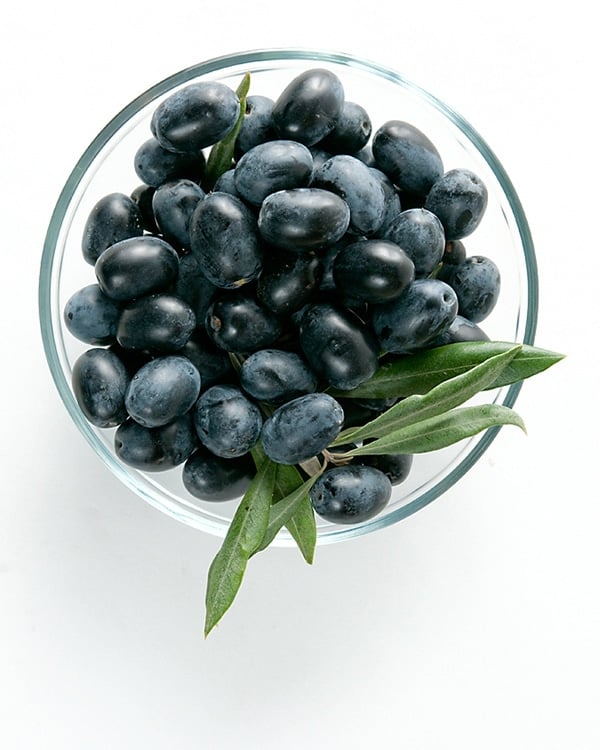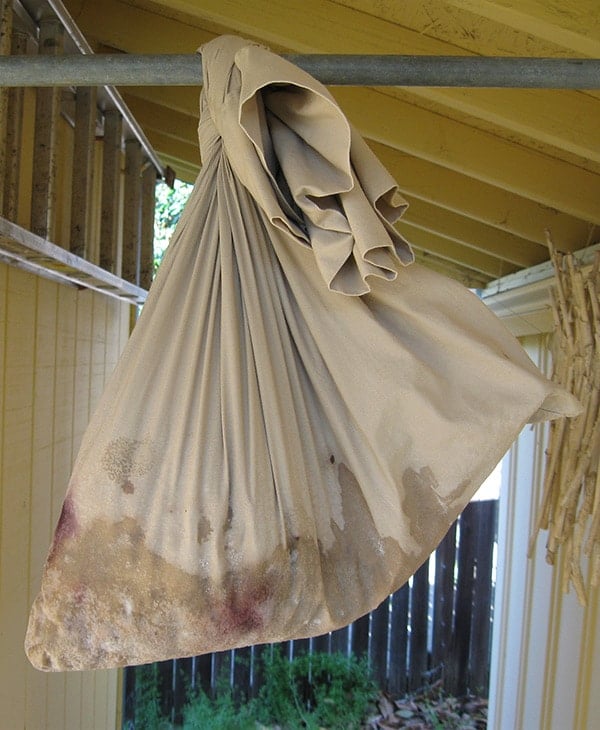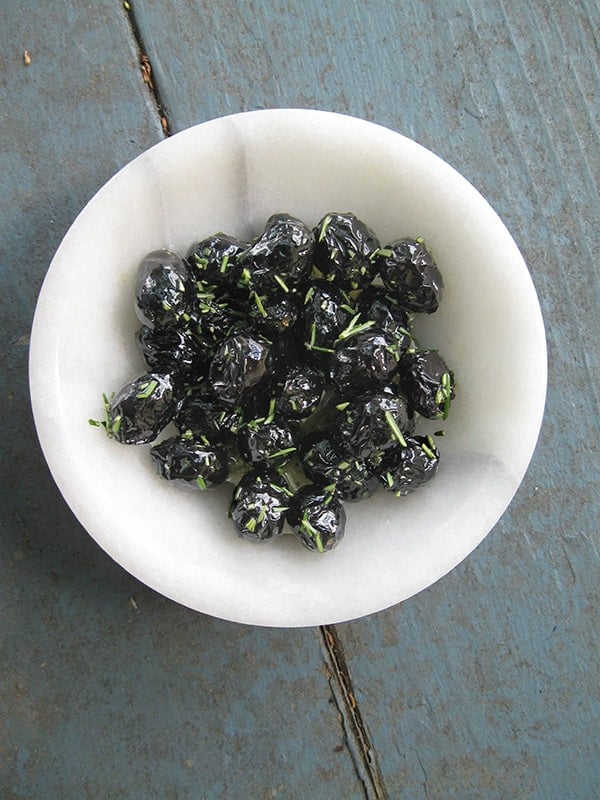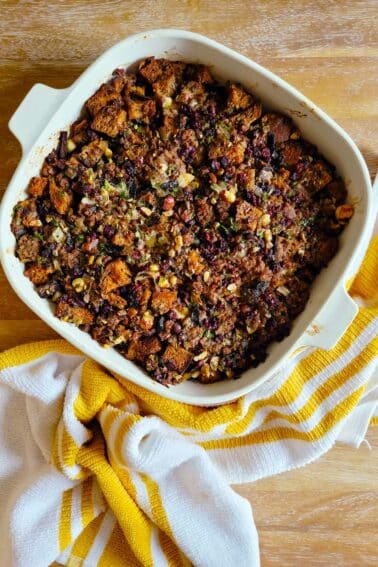As an Amazon Associate I earn from qualifying purchases.

Here in Northern California, olive trees grow all over the place. And every autumn since 2004, I’ve gathered green olives from a park near my house to make batches of brine-cured olives and lye-cured olives. Each have their place on my table. Black olives come later.
I like the typical black kalamata-style olive, but don’t love them. What I prefer are those wrinkly oil-cured black olives. Fortunately, you make them with very ripe olives, which means late January or February here in NorCal.
Black olives will hang on the tree for months, and as it rains, they get less and less bitter. If you can catch some very late, as in early spring, you can kinda-sorta eat them off the tree.
Olive fly is a scourge on our local trees. The flies lay eggs on the olives and the larvae burrow into the olive, leaving a tell-tale scar that looks like someone branded the side of the olive with a hot pinhead.

Normally I have to toss every third or fourth green olive, picking my way through to the clean ones. But late-season black olives are almost completely free of larvae.
I can’t be certain, but what I think happened is that throughout the long winter, all the olives infected with the parasite had already dropped off the trees; rotten olives surrounded each one. By March, all that was left were good ones.
On a good day I can gather about three pounds’ worth of black olives in no time.
Five weeks later, you will have fantastic oil-cured black olives. In fact, I don’t think anyone ought to pick black olives before February. In three pounds of olives, I typically have maybe 20 infected with olive fly. And the months of weathering on the tree — all that chilling and rain — had already leached out some of the bitterness from the olives.
And they are beautiful. They look like they ought to be delicious right off the tree. Sadly, they aren’t. Edible, but only barely. The good news is that oil-curing is just about the easiest method of curing olives. Once you’ve picked through all the olives to remove any with olive fly larvae scars, you only need three things to do this:
- A pillowcase or other sack
- Salt (kosher or pickling or cheap sea salt)
- Time.
How much salt? You don’t need to be exact. A good ratio is about 1 pound of kosher salt to 2 pounds of fresh black olives. You can go a little over or under this if you’d like, but err on the side of more salt, not less. Pour the salt into the pillowcase, then the olives, and mix them all around so the olives are covered.
Hang the pillowcase somewhere that black, dripping olive juice won’t matter. I hung the case between the two sheds in our backyard. Yep, that’s right: You can do this outside. Weather doesn’t matter, and some sources say the cure is even better of everything gets rained on once in a while.

Attend to your olives once a week or so, to mix them around again and make sure they are still well-covered in salt. The earliest they might be ready is a month, but they should definitely be cured by six weeks.
After a month, take one out. The olive should look wrinkly, taste salty and be just a little bitter. These olives will always be more bitter than those done by the lye-curing method. I like that little hit of bitterness. Take them out of the salt when they are “sweet” enough for you, or after six weeks, whichever comes first.
You will notice something. No oil. While these olives are known to one and all as “oil-cured,” they are not actually cured in oil at all. They are cured in salt. The oil comes next.
I made 3 pounds of these olives, far more than I could reasonably eat in a normal amount of time. And while they look mummified, these olives are quite perishable. Left alone at room temperature, the oils in the olives will begin to turn rancid in a month or two. In the fridge, however, they will last a year if you store them properly. Here’s how:
- Arrange the cured olives in one layer on a cookie sheet and allow to dry overnight. Sometimes a little olive juice gets on them during the curing process, and you want this to evaporate before you put the olives in for long-term storage.
- When they’ve dried overnight, mix the olives with about 1/2 pound of salt for every 4 to 5 pounds of cured olives. Store in an airtight container.

When you want to eat them, some sources say to boil the salted olives for a few seconds to remove some of the saltiness. Boiling will also plump up the olives a little. You don’t have to do this, as the olives are excellent either way. What you do need is marinate them in olive oil for at least a day. This is where the oil-cured part comes in.
You can completely submerge your cured olives in oil, or just coat them in it. Your choice. Definitely include a chopped fresh herb such as rosemary, sage, thyme or oregano. A little lemon zest would be nice, as would some cumin or black pepper. But don’t gussy up these olives too much. Their allure is in their simple, briny richness.
Once marinated, eat the olives within a few weeks or so.




Ed: They are supposed to be salty. Boil the next time for 2 minutes, maybe? And I have never stored them in water or vinegar, so you are on your own with that one.
Lauren: Yeah, that’s part of the deal with these. Could be the variety of olive you are using. I generally put my finished olives in the fridge, because I make so many and they take a year or so to eat them all. But I don’t see any reason why they wouldn’t be fine at room temperature.
Just finished my olives and I love them but everyone who tries one says there isn’t much meat on the stone (pit). Is that just the reaction to all the salt? Once the olives are re-covered with salt for storage, should they be put in the refrigerator or just in a dry place?
My dry cured olives are very salty even after boiling them for a minute. Is there any way to get rid of some of the excess saltiness? Can I store them in water or in vinegar?
@Rose White…you can order olives from Penna when they’re in season.
https://www.greatolives.com/buy-gourmet-olives/index.php?route=product/category&path=38
I was able to get 10lbs with shipping for $30. Very reasonable. Start checking their website in mid-Oct for green. Those ripen up and then you can get the ripe in Nov.
I just dry cured some colossal ripe, end of season Sevillano olives. Amazing! Mine were ready at a month. I put them in a gigantic non-reactive colander after totally covering them with salt. This was placed over a plastic tub to catch the drippings and covered with a towel. I don’t have any place outside to hang them so I made do. I did 10 lbs. Next year I’ll invest in some more and make a HUGE batch! I’ve done green and ripe in brine but I think I’ll stick to the dry salt cure. I’ve also experimented with using baking soda on the green to get rid of the acid that causes the bitterness. Did it with a small batch and I feel there’s promise for that method. Too bad one can’t get fresh olives all year! My house would become an olive processing plant! Lol!
My compania has showed me that I have spelled coarse, as course. Anyways I am in a far away place for me, learning a different language. It is sale grosso, and usually people put it in pasta water. I looked up coarse salt, and came upon kosher salt, with references to pickling salt, and before I did that the olives were already hanging in the shed. Thanks for the precision articles, recipes, and the great writing. Whenever I come to look for a recipe I often get distracted by the drooling over of new and delicious things.
Can I use course sea salt? I happen to have a bunch of it.
Rose in Wisconsin, I think you are out of luck on ‘purchasing’ fresh olives. We were just in California and saw some olive trees with ripe luscious black olives and asked the owner if we could pick some. They were more than happy to not let them hit the ground, so in about a half hour we had 10-ish pounds and they are sitting in cloth grocery bags with salt right now. Your best bet is to locate a friend of a friend and have them mail you some, maybe, but the black ones we picked were so soft and ripe I doubt they would ship well….
we and our friends in Moab will soon be enjoying home cured olives!
I have an old family recipe that calls for boiling the olives for 5 minutes before allowing the olives to cool to lukewarm and then oil curing them. Here in Wisconsin, we don’t have olive trees. Any idea where I would purchase the fresh olives?
i have waste my black olives 4 last few years ,try too many ways,yours seems to be very easy ,hope it works on my black olives
Another reason I am glad Ifound your site, I gotta try this next spring. NAS Lemoore has 9 trees I know of and I will plunder them this year. 😀
Keep doing what you do.
Excellent guide on making oil-cured olives. I’ve always wanted to try this but never had the time nor the knowledge.
Bill: I’ve used drain cleaner before and have suffered no ill effects. Just look for 100 percent lye on the label. There is no proven difference between “food grade” lye and drain cleaner — I’ve seen plenty of evidence they are made in the same factory and just shipped in different bottles. BUT, the “food grade” stuff is, allegedly, guaranteed to not have any trace amounts of heavy metals.
For me, I’ll stick with the drain cleaner. You use a tiny amount, after all. But there’s no reason not to buy the food grade stuff if you can afford it.
I got turned on to oil-cured olives in high school when I followed a buddy of Italian extraction home and her nonni gave us bread and oil-cured olives for an after school snack. I’ve been a fan since then and we won’t talk about how long ago that was.
Bill May should know that food-grade lye can be had from essentialdepot.com; it where my husband gets his for his soft pretzel making.
I did some lye-cured olives back in my college days and the end product was delicious. I’d love to do it again, but guess what? Lye isn’t as easy to find as it once was. I think I used a bottle of DRANO to do the trick…
Saw some olive trees at the local big-box home-improvment store the other day that were rated for zone 8. Too bad I don’t have a spot for them. (Damn you, you ~75 y.o. pecan tree).
Buena receta, yo vivo rodeado de olivos.
Saludos desde Jaén.
Your green olive posts are what endeared me to your writing, and since then I’ve dreamed of living somewhere where I could pick and cure my own olives (soon, I hope).
I’m now looking forward to black olives too.
Thank you!
Oil cured olives. To me, the words act like the ringing of the bell did for Pavlov’s dogs. The best commercially available olives cured this way that I’ve had were from Morocco, but I’ve purchased some at the local co-op that came from who knows where that were absolute crap. A faculty member in my dept. went to CA last spring and picked some black olives to cure, and they were the best I’ve had. Thanks for putting your recipe/methods down on paper. I need to do this, and I appreciate the inspiration.
I oil cured some a couple years ago. I used a brine rather than dry salt. I refreshed the brine every two days. I will have to give the dry salt method a try. Seems simpler. Picking in Spring also sounds like a good idea. Everything happens at once in the fall/winter.
Thanks!